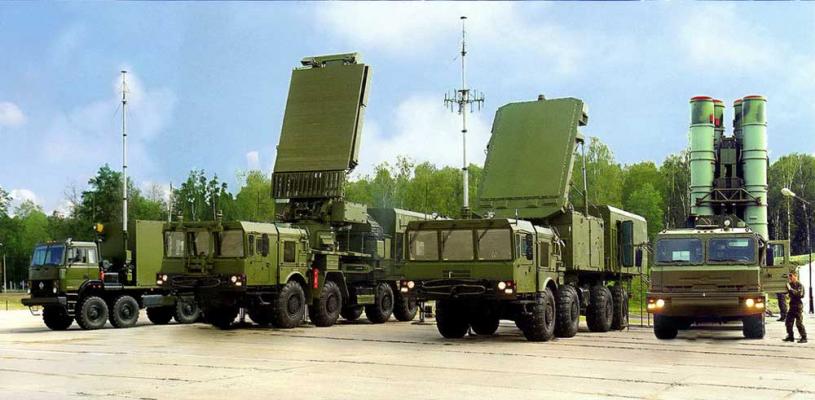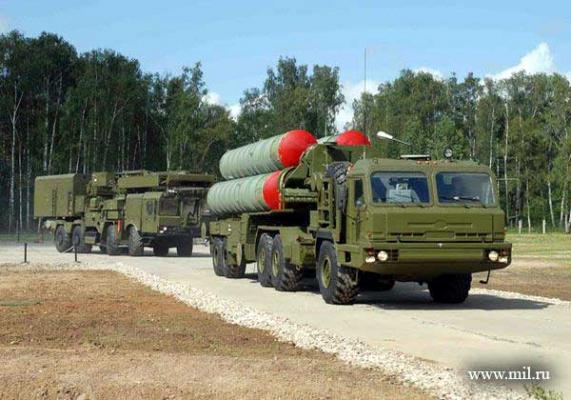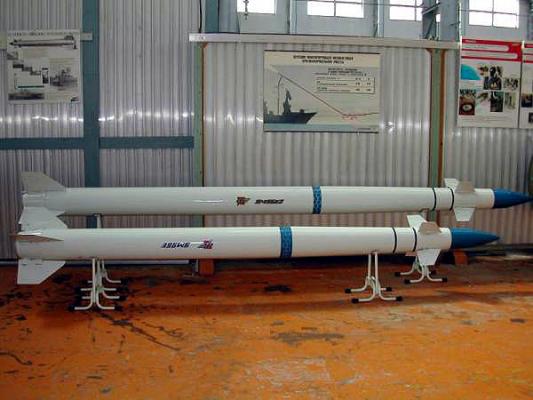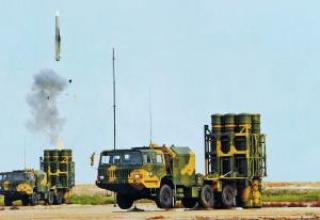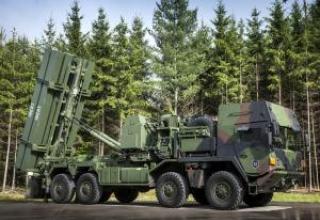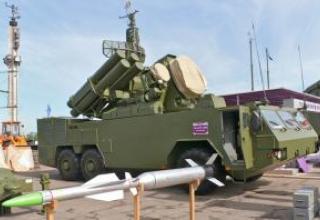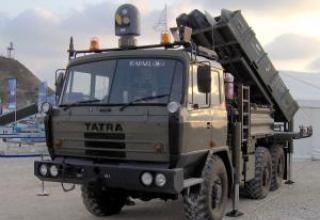The anti-aircraft missile system С-400 "Triumph" is intended for defeat of jammers, radar detection and control planes, reconnaissance planes, strategic and tactical aircraft, tactical, operational-tactical ballistic missiles, medium-range ballistic missiles, hypersonic targets and other modern and perspective means of air attack.
The S-400 SAM system is based on the existing Russian S-300 systems, but has significantly greater tactical and technical capabilities than these systems, both in terms of area, effectiveness and variety of targets. Evaluations conducted by the developers of the complex revealed that the new SAM system provides a gain of 2.5 times as much as the existing equipment on the criterion of "efficiency - cost". "Triumph" is the only system that can selectively operate using several types of missiles, both the old ones that were part of the early development (S-300PMU-1, S-300PMU-2) and the new ones that have been created recently. Having 4 types of missiles with different starting mass and launch range in the basic version, the S-400 allows to create an echelonized anti-aircraft defense, expand the zones of destruction of the complex, and also has great prospects for further modernization.
The high degree of automation of all stages of combat operations and the modern element base made it possible to significantly reduce the personnel of the S-400 SAM system. The principles of construction and the ramified communication system of the "four hundred" make it possible to integrate it into various levels of control not only of the Air Force, but also of other branches of the Armed Forces.
The main developer of the complex is the Central Design Bureau "Almaz" (General Designer A. Lemansky). The leading enterprises of the Russian defence industry - Fakel ICD, Novosibirsk Research Institute of Measuring Instruments, Special Machine Building Design Bureau (St. Petersburg) and a number of others - are included in the development cooperation.
The S-400 anti-aircraft missile system was adopted by the Russian Army by the Russian Government Decree of April 28, 2007. On August 6, 2007 the first division took up combat duty in Electrostal, Moscow Oblast.
On August 6, 2007, the first division took up combat duty in Electrostal, Moscow Oblast. In the west, the complex was designated SA-20.
Composition:
The basic version of the S-400 antiaircraft missile system retains the structure of S-300 type air defence systems, including multifunction radars, launchers, autonomous detection and target designation means. At the same time, the new control system provides a much greater channel to targets.
Triumph" SAMs are part of the structure:
- Controls 30K6E:
- Air defense missile systems 98Zh6E (up to 6 pcs.) as part:
- Optionally, the funds are given:
- the 96L6E all-altitude radar;
- 40B6M mobile tower for 92H6E antenna post.
All processes of combat work - detection, route tracking, distribution of targets between anti-aircraft missile systems (SAMs), their capture, escort and identification, the choice of missile type, preparing them for launch, launch, capture and pointing missiles at targets, evaluation of the results of firing - are automated.
The command post of the SAM has the radar 91N6E, which creates a radar field in the area of the system and carries out the detection, route escort and identification of all types of targets in an amount of hundreds of units. The detection radar 91N6E operates in a circular view mode, is three-axis, noise-protected. This radar has an important advantage over ground-based duty and combat radars and is equipped with a two-dimensional scanning radar beam.
According to the detection radar, the command post distributes targets among the guided anti-aircraft missile systems of the system, provides them with appropriate target designation, as well as the interaction of the SAMs in the conditions of massive raids of airborne attack vehicles at various altitudes of their combat application, in an environment of intensive radio interaction. The command post of the SAM system can also receive additional route information on targets from higher command posts to which ground-based radars of duty and combat modes are closed, or directly from these radars, as well as from onboard radars of aircraft systems. The combination of radar information received in different wavelength ranges is most appropriate in a situation of intensive radio interaction. The Triumph" SAM system can control up to 8 SAMs simultaneously.
SAMs are equipped with monopulse four-axis sector multifunction radars (MFRLS) 92N2E. The SAMs use a combined SAM control system consisting of an inertial control system for the most part of the trajectory and homing heads (Homing Head) in the approaching area. This allows at the stage of inertial control to free the channels of multifunctional radar from the function of escorting the SAM and increase the number of simultaneously accompanied and fired targets. The use of active homing heads frees the MFRS from the function of tracking and illumination of the target in the homing area, which also expands the radar capabilities in terms of the number of accompanied targets. There are plans to use in SSDs prospective combined active and semi-active CNS, which also have a passive receiving channel, capable of searching not only the frequency of the received signal, but also the target search by angular coordinates.
One launcher can accommodate four ultra-long range missiles (up to 400 km) designed to engage DRLO aircraft, air command posts, REB aircraft, strategic bombers and ballistic targets at a maximum speed of more than 3000 m/s. It will be able to destroy aircraft beyond the radio visibility of ground guidance locators. The need to engage over-the-horizon targets necessitated the installation on the missile of a brand new homing head (Homing Head), developed by the Central Design Bureau "Almaz", which can operate in both semi-active and active mode. In the latter case, the missile, after gaining altitude on command from the ground, is put into search mode and, having detected the target, is guided on its own.
In the other version of the launcher equipment - four transport - launch containers with four missiles type 9M96E or 9M96E2 in each. These missiles are capable of attacking all existing and prospective missiles and aircraft at medium range. The 9M96E/9M96E2 ZUR are similar to the foreign Patriot RAS-3, Aster-30 missiles in their purpose, but they are much more efficient.
The 9M96E and 9M96E2 missiles are fully unified for interspecific applications in air defense systems of both the Air Force and Navy. A significant reduction in the size and weight of these missiles made it possible to place them on four missiles in cassettes-containers, which have similar dimensions with containers, which are included in various versions of the S-300PMU and "Reef" SAM systems - 5B55R, 48H6E, 48H6E2, 48H6E3. Such an increase in ammo stockpile predetermines a much greater flexibility in the use of missiles and makes it possible to effectively counteract the depletion of the air defense system through the use by the enemy of massive attacks with high-precision missiles or their simulations by remotely piloted aircraft.
9M96E2 is optimized to combat high-precision weapons, cruise missiles and ballistic targets, including those with low visibility. It not only destroys air targets, but also undermines their combat unit. The probability of a single missile hitting a given target without regard for operational reliability is:
- at least 0.9 for manned purposes, including stealth technology, barrage and anti-vaultigation manoeuvres;
- at least 0.8 for unmanned targets, including those performing a counter-aircraft manoeuvre (with a probability of at least 0.7 being accompanied by the destruction of their combat load).
Control 9M96E2 - combined. On the most part of the flight path to the target, the missile is controlled by an onboard inertial system using ground radar information on target coordinates entered into 9M96E2 onboard equipment by ground means of air defense systems before the launch and corrected during the flight along the correction radioline. In the final section of the flight, the missile is guided by the data produced by the active homing radar head.
The missile's target range of 9M96E2 is 120 km and its height is from 5m to 30 km, mass is 420 kg. The time to prepare the missile for launch when it is on PU no more than 8 seconds. Designated service life - 15 years. This period can be extended after technical inspection of 9M96E2 in the places of their operation.
9M96E and 9M96E2 are fully unified in terms of the composition of onboard equipment, combat equipment and design, the 9M96E rocket differs from 9M96E2 in its characteristics. Its target range is 40 km, its height is 20 km and its weight is 333 kg. The engine power of the 9M96E is less than that of the 9M96E2, but the dimensions and masses are almost the same.
The main feature of modern air defense and missile defense is the necessity to destroy the combat load of the attack means, i.e. the intercept should result, for example, in guaranteed exclusion of the probability of the attacking missile's combat load dropping in the area of the defended object. This possibility can be completely eliminated only if the combat load of the target is destroyed during the interception by the anti-aircraft missile. In its turn, such a result can be achieved either by direct hitting of the missile in the warhead compartment of the target, or by combining a sufficiently small miss and effective impact on the target energy of the air defense missile fragments.
Unlike their foreign counterparts, 9M96E and 9M96E2 use a "cold" vertical start - before starting the marching engine they are ejected from the container to a height of more than 30 meters. During the ascent to this altitude, the missile, using a gas-dynamic system, tilts towards the target. After starting the marshal engine, inertial control with radio correction is used at the initial and middle parts of the flight path (which allows for maximum interference immunity), and active radar homing is used directly during the target interception. If intensive maneuvering is required in front of the target meeting point, the missile is able to implement a "super maneuverability" mode, for which the gas-dynamic control system is used. This system allows for 0.025s to increase the aerodynamic overload of the missile to the value of about 20 units. It should be noted that the application of the system of "super maneuverability" of 9M96E and 9M96E2 missiles along with the increased accuracy of guidance allows for the implementation of guidance trajectories that improve the conditions for the missile to meet, increasing the effectiveness of the use of combat equipment of anti-aircraft missiles.
9M96E and 9M96E2 are equipped with a 24-kg shrapnel fighting unit with a controlled kill field. The development of the 9M96E and 9M96E2 missiles' information-aided guided combat equipment was another way to improve the effectiveness of modern airborne attack equipment. Such equipment is designed to engage targets with "stop" effect (destruction of structure) when intercepting manned targets and to engage (neutralize) the combat load when intercepting unmanned targets. The missile's combat equipment is controlled by a radio detonator, which uses all the information available on board the missile to adapt to the conditions of the target meeting. The radio detonator determines the moment of detonation of the combat unit, which must be strictly coordinated with the velocity of the fragments to cover the vulnerable target part with a shrapnel field and the direction in which the fragments must be ejected at higher velocities. The directional fragmentation ejection is accomplished by the use of a guided high-explosive high-explosive warhead with a multi-point initiation system. This system, when commanded by a radio detonator to trigger a warhead in controlled mode (if there is information about the missed phase), initiates its charge at the peripheral detonation points corresponding to the required direction. As a result, the energy of the charge explosion is redistributed in a given direction and the main part of the fragment field is thrown at increased velocity towards the target. In the absence of information on the phase of the miss, a centralised warhead detonation is realised with a symmetrical dispersal of the fragments.
New important characteristics of the Triumph SAM are:
- information interfacing with a large number of existing and under development land, air and spacebased information sources;
- use of basic-modular construction principle, which allows to meet specific requirements to systems when used in the Air Force, Navy and Ground Forces;
- possibility to integrate into existing and future air defense group control systems not only the Air Force, but also Navy air defense forces and facilities.
One of the additional sources of information for Triumph's SAMs is the Airborne Radar Surveillance and Guidance System (AK RLNDS). According to the existing concept, RLDPN carries out reconnaissance of the air enemy to ensure combat operations of fighter aircraft and long-range SAMs. In addition, RLDPN AKs, which are more survivable than ground-based radars, are used to build up and quickly restore the radar field.
The type of RLDPN aircraft in the Russian Federation includes the A-50 complex and its upgrade to the A-50U with the radio technical complex (RTC) of the Shmel-M coherent type. The all-around vision antenna system installed above the fuselage of the IL-76 enables high resolution detection of airborne objects in a wide range of flight altitudes, control of fighters and exchange of combat information with them. It is envisaged to develop prospective radar stations based on the use of various types of RTK.
Scientific, technical and technological breakthroughs achieved during the development of the Triumph SAMs provide a real opportunity to move to the development and production of a new class of weapons - integrated information and fire aviation and anti-aircraft missile systems.
The integration of information and missile systems of the Air Force into a single system can be carried out using the following options:
- creation of an information and fire system where all ground and air reconnaissance assets are used to provide information support to the NPRAs and the management of the launched NPRAs is carried out on the basis of the IFRLS own information (IOC-I);
- creation of an information and fire-fighting system, in which all the above mentioned means of information support are provided, but the launched SAMs are managed based on external information (IOC-II);
- the creation of an information and firefighting system in which the information support is provided by all the above means but the launched SAMs are managed from a fighter aircraft (PSI-III).
PICs I, II, III can be considered as stages of a full-scale integrated PIC; in a full-scale integrated PIC they can be considered as environment-dependent operating modes. A common challenge in the development of these systems is the provision of combat information to the SALWs that meets the requirements of accuracy, discreteity, completeness and time of issue.
This is not a key issue for IOC-I, as it provides for the operation of an ASW on its own information. The level of provision of ground control points, including SAM systems, reconnaissance aircraft and fighter aircraft information is high enough and can practically meet the requirements of the Triumph SAM system to solve the problem in question.
For the IOC-II, the main sources of information may be fighter planes and RWDN aircraft. Thus, omitting the questions of accuracy, discreteness and completeness of information output from fighter LRBMs on the "Triumph" SAM system, on the basis of preliminary estimates we can say that according to the time balance the SAMs can be fired at the maximum range according to the information from fighters during the SAM cycle, and the detection range of an attacked target of the LRBMs practically at the maximum ranges of the LRBMs. The time and range of information from fighters can be shortened if the target targets are opened by their own LLRSs after the LLRS is launched. However, such interaction between the IA and the SAM system at this stage seems rather complicated, as before and after the launch of the SAM system it is difficult to predict the possibility of opening the target by the SAM system's own reconnaissance means.
In case of interception of targets with low radar visibility, interception under interfering conditions, CR type targets when shooting over the radio horizon, information support from radar and fighters may consist in providing information on target coordinates, flight sector with respect to the SAM system, which can be used by the SAM system for early target opening, specifying target classes and types and pointing SAMs at them.
The most difficult is the creation of EOS III, which requires both the above problems and the management of SAMs from interceptor fighters. The problem of SAM control from fighter planes requires fundamentally new tasks to be solved:
- solution of the task of preparing initial data for the launch of LSD on external information;
- choosing the moment of starting the LSD;
- transfer of the SAM control to the fighter weapon control system;
- control of the SAM system on the trajectory from a fighter aircraft to the target, control of the transition of the SAM to homing and control of the firing results;
- providing multi-channel control.
The key problems in the direction of the implementation of the SHI are in the field of development of fighter jets, its information and sighting system and radar, communication system and LSD control system.
There are several solutions to this problem in general.
A full-scale and reliable solution from the point of view of realizing maximum combat capabilities is the creation of a combined SAM system, including inertial control at the initial flight section, radio correction of SAM on the trajectory, semi-active homing and active homing at the final stage. Combinations in the control system are possible, but in general such a solution meets a number of requirements inherent to the integration of SAM systems - IA in terms of SAM control from a fighter aircraft. Essentially, such a control system provides precise knowledge of the phase coordinates of the SAMs on board a fighter, which can be ensured by the presence of an inertial system on board the SAMs and a fighter-to-fighter communication system. It is expedient to work out in the SAM control system the issues of installation of a high-precision inertial system on board the SAM system, as well as the issues of implementation of semi-active SAM homing when illuminating the target from the fighter. It can be expected that the highest efficiency and productivity of the IOS-III will be achieved when realizing the maximum launch range of the SAMs and, accordingly, the maximum range of the fighters' LRBMs, which requires the selection of rational fighter duty zones when organizing the interaction between the SAMs and the IA.
The process of interaction of the "Triumph" SAMs with the IA in case of their joint actions should provide for a significant participation of the personnel of combat operations of the SAMs and IA control and command-and-control units (MPCs) in the distribution of forces of subordinate means and in ensuring flight safety of fighters in the SAMs' firing zones.
Possible ways to improve the effectiveness of interaction between the IA and aviation security in areas affected by a prospective "Triumph" SAM system are as follows:
- increased automation of work processes;
- interaction of the SAM control system with several aviation control systems and IA;
- expansion of the volume of information transferred to the SAM control.
The implementation of the proposed concept of creating information and fire systems will give a significant economic benefit, as it will reduce costs at all stages of the life cycle of systems, including through optimization of development and production processes based on the use of advanced design solutions, deeper unification of means. During the operational phase, troop numbers and equipment costs can be reduced by eliminating redundant controls and automation systems.
Characteristics:
| Target detection range, km | 600 |
| Number of simultaneous target traces | up to 300 |
| The view area of the radar (azimuth x angle, deg: - aerodynamic targets - ballistic purposes |
360 х 14 60 х 75 |
| Defeat zone in range, km: - aerodynamic targets - ballistic purposes |
2-240 7-60 |
| The height of the target, km: - minimum - maximum |
0.01 30 |
| Maximum speed of the target, m/sec. | 4800 |
| Number of simultaneously fired targets (full SAF) | 36 |
| Number of simultaneously guided missiles (full SAM) | 72 |
| Time to deploy the SAM from the march, mines | 5-10 |
| Time to put the system's assets on alert from the deployed state, min. | 3 |
| Working hours of the system means before the overhaul, h | 10000 |
| Operating life, years: - ground facilities - anti-aircraft guided missiles |
not less than 20 15 |
Testing:
In 1974, the RPU-14 rocket launcher was still in service with the Soviet Army and was used in mountainous conditions.
Sources:
- Военный парад - Номер 33. Май - Июнь 1999
- А.Сумин,В.Гиндранков,Г.Колпаков "Интегрированные информационно-огневые системы. Перспективы и проблемы."/www.vko.ru/
- Вестник ПВО
- В 2005 году на вооружение российских ВВС будет принят полк зенитных ракетных систем С-400
- ЗРС «Триумф» /рекламный буклет НПО «Алмаз»/
